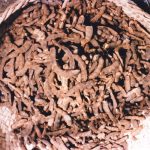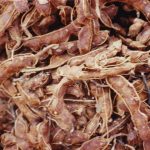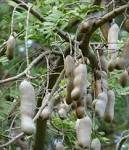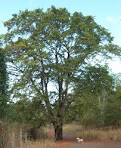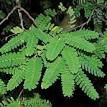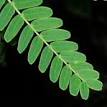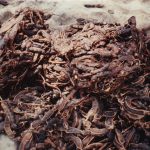Tamarindus indica
Uses
India. Seed kernels commonly sun-dried or roasted over a fire, then ground into flour and used as such, or mixed with other grain flour. (Bombay Presidency): leaves and seeds eaten. Unspecified part of plant reported mixed with Arisaema murrayi Hook. and Arisaema tortuosum Schott. [ARACEAE] while cooking; (region not specified): seeds roasted, ground into flour, and baked into bread[sic](chapati?). Maharashtra State (Thane): the Warli tribe prepare a soup from the dried, powdered leaves mixed with the roasted roots of certain yams (kadu kanda) – including Dioscorea bulbifera L. and Dioscorea purpurea Roxb. (Madras Presidency): leaves, young shoots, and fruit eaten. Seeds converted into meal; (Rajasthan, western): leaves, fruit and flowers eaten. Fruit used for making juice. Seeds fried and eaten separately or mixed with Jowar (sorgum) or Bajra (millet) [or other coarse grains(sic)]. Seeds and leaves eaten raw of pounded and mixed with other grains. The Santal tribe, of northeastern India, combine the seeds with the flowers of Bassia longifolia var. lattifolia Roxb. Nigeria (Kano State, northern): pods, leaves, fruits, seeds and flowers eaten. Sudan (especially southern Darfur and southern Kordofan): fruit pulp eaten, and mixed with porridge; fruit pulp also used as a base for a beverage; green leaves mixed with ground sesame or groundnut [peanut] and used as a salad. Chad (central): fruit eaten. Ethnomedical uses – India – powdered seeds used to treat rheumatism, herpes, stomach complaints, promoting suppuration of ulcers. Sudan: fruit pulp beverage used for reducing fevers and as laxative. Zambia (Gwembe Valley) the Gwembe Tonga people eat the seeds.
Nutrient composition of a Nigerian seed sample:
Ca = 142 P = 220 Mg = 201 Cu = 0.26 Mn = 0.70 Zn = 3.12
Fe = 9.09 Protein = 16.7
Leaves. Amino acid composition and protein quality, compared with FAO reference protein (values in mg amino acid /g N). Mali sample, from Nordeide. Isoleucine = 301 Leucine = 475 Lysine = 287 Methionine = 71 Cysteine = 90 Phenylalanine = 245 Tyrosine =182 Threonine = 239
Tryptophan = 59 Valine = 287 Histidine = 124
Fruit. Amino acid composition and protein quality of compared with FAO reference protein (values in mg amino acid /g N) Mali sample, from Nordeide. Isoleucine = 269 Leucine = 419 Lysine = 195 Methionine = 11 Cysteine = NA Phenylalanine = 238 Tyrosine = 253 Threonine = 19562 Tryptophan = 62 Valine = 250 Histidine = 79
Additional Information
- Name Authority:
- L.
- Vernaculars:
- India: Bombay Presidency Bijapur district, Bilgi : Chinch, Amli, Hanshi. Rajasthan, Jaisalmer district: Imli. Rajasthan (western): Imli. Tamil: Poolia marum. Telugu: Chinta chettu. Chad (central) (Arabic): Aedep. Sudan (Arabic): Aradeib. Nigeria (Hausa): Tsamiya. (Kanuri) Tamzu, Tamsugu.
- Misc:
- Chemical composition: Protein (crude) = 4.8% (dry). Fat = 0.4% (dry). Fibre (crude) = 6.6% (dry). Ash (insoluble) = 3.8% (dry). Carbohydrate (soluble): Starch = 12.7% (dry). Sucrose = 0.4% (dry). D-glucose = 12.7% (dry). D-fructose = 11.1% (dry). Amino acids (g [16g N]-1: Aspartic acid = 6.2g. Threonine = 2.7g. Serine = 3.5g. Glutamic acid = 5.6g. Proline = 33.1g. Glycine = 3.1g. Alanine = 3.1g. Valine = 3.7g. Cysteine = 0.8g. Methionine = 1.0g. Isoleucine = 2.9g. Leucine = 4.3g. Tyrosine = 3.1g. Phenylalanine = 3.7g. Lysine = 3.7g. Histidine = 2.3g. Arginine = 2.5g. Minerals: Sulphur = 0.03% (dry). Potassium = 0.10% (dry). Magnesium = 0.14% (dry). Calcium = 0.26% (dry). Na = 0.01% (dry). K = 1.32% (dry). Zinc = 9mg/kg-1 (dry). Iron = .73mg/kg-1 (dry). Manganese = 2mg/kg-1 (dry). Copper = 5mg/kg-1 (dry). Aluminum = 44mg/kg-1 (dry). (Mozambique sample (fruit pulp) - Protein = 3.1%[/100g?].Fat = 0.1%[/100g?]. Fiber = 5.6%[[/100g]. Carbohydrate = 65.71%[/100g?]. Calcium = 170mg/100g. Phosphorus = 110mg/100g. Iron = 10.9mg/100g. Vitamin C = 3.0mg/100g. Soil types favored by plant (Rajasthan, western): alluvial and sandy plains.
